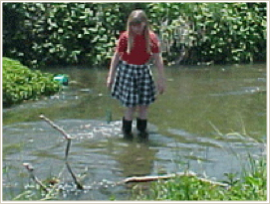


We
saw the new Harry Potter movie the other night. I didn’t like it as
well as the last one. A velocity issue, I think. The previous one I
recall as being quietly menacing; this one was things coming at you fast
with loud scary music. One line, however, endeared this one to me. The
villain, a bureaucrat acting as teacher, tells the students at one point
that something, a new textbook I think, will help them pass the
examination, and that is, after all, the point of education—to pass the
examination. She is convincingly portrayed as a truly awful person and
yet one we are all familiar with, and her statement seems the logical
extension of the No-child-left-behind philosophy of education.
I
told my friend Judy Fjell some educational observations of mine—she
teaches music in public schools—and she asked me to write them up for
her. I pass them on to you, because they are about the parts of every
child that get left behind when test scores mean everything and only
reading, writing and math are tested—not science, not the social
sciences, and most certainly none of the arts.
WORD WEAVING
Around
1982 I was in a project in a number of Bay Area schools where a few
classes in each school were given extra storytelling, both from pros
like me and from the classroom teachers who had attended workshops we
gave. At the end of a year, the children were tested, along with
same-grade children who had not had storytelling. The storytelling
children were very slightly better in reading scores, vocabulary tests,
recall of story elements, etc., but not in statistically significant
ways. The statistically significant difference came in the following
test. The children were told a story they hadn’t heard and then asked
what happened next. The control group typically answered “Probably the
same thing,” or “I don’t know...she didn't say.” The Word Weaving group
typically added new, imaginative story elements.
The
teachers also reported that in their observation, their classes’
listening skills improved more in the year they did storytelling than in
previous years. Some teachers reported that the storytelling seemed
particularly useful in drawing out shy and ESL students. I had an
example of that in one fifth-grade class with several ESL students. I
had just done a string-trick story, then, on impulse, I made the
cat’s-cradle opening and asked if anyone would come up and do it with
me. An Asian girl came up, and we went through the whole sequence. I
thanked her and she sat down. As I was leaving, the teacher told me she
had just come to this country, had been in school about a week, and this
was the first time she had volunteered to do anything.*
VIDEO STORYTELLING
Also
in the eighties, I flew to Indianapolis to have four stories recorded
by a videotape company that was putting out a series of eight or so
storytelling videotapes. I asked for a fifth and sixth grade audience
and that’s what I got.
A
few months later, I got a phone call from the company. They wanted to
add some drawings here and there in the stories on my tape The marketing
people felt they were needed because in test showings the children
didn’t keep their eyes on the screen. I explained that in storytelling
they didn’t need to. Sometimes they were looking at me, sometimes they
were looking at scenes from the story in their mind’s eye. The guy
didn’t buy that. I told him about a five-year-old newcomer at a library
story hour who seemed too busy looking all around him to take in the
stories. Then at the next story hour, his mother reported that he
recounted all the stories to his father. You can’t tell by looking if
they’re listening or not. He still felt they needed pictures. I got very
loud. We had several loud phone calls. Luckily I was at a week-long
storytelling workshop and got lots of support from the other tellers.
I
explained to the guy that his test was not valid for video, that it was
for a different medium, TV, where the station is selling the kids’ eyes
to the advertisers, but he is selling videos to the kids’ parents, and
the test should be whether they want to view the tapes again another
day. No dice. I threatened to bad-mouth the videos in my workshops and
classes.
Finally,
he said he would not have pictures inserted in my tape because the
stories were for older kids, but he would put them in the other tapes.
“SINK” STORY
I
was in a training weekend for artists in residence in Idaho schools.
The trainer said, “I’m going to say a word and I want you to note the
first thought that comes to your mind when I say it. The word is
‘sink’.” Then she asked us what our responses were. Somebody saw the
noun, a kitchen sink. Somebody saw the verb, a ship sinking. I (mostly a
kinesthetic thinker) thought a downward motion. The professional
musician among us saw a recording studio. Huh? Well, he explained, he
heard ‘synch’.
The
leader asked if anyone had seen the written word, SINK. Nobody had. But
that’s the main way we expect kids to learn, she said, and we think the
arts are dispensable.
In
fairness, I have since met one person who says she sees words running
under her mental image screen like news flashes on TV, and she said
she’d met two others in her life who think that way, but they seem to be
a small minority. Anybody out there have this experience?
MULTIPLE INTELLIGENCES
Some
years ago, I went to a “Kids in Creeks” conference at Mills College. In
one of the big auditoriums there, a series of teachers was presenting
work they had done with kids in creeks, all very impressive. Then a
group of fifth graders presented the work they had done the previous
year in fourth grade. The state provides a list of creatures endangered
in each county. Of several in Marin, they chose a tiny shrimp that lives
in the streams. Because cattle had been trampling the foliage that
shaded the streams, the poor little shrimp were huddled under highway
overpasses for shade. The kids campaigned to get ranchers to fence the
streams. Kids also raised money for native plants they would plant to
replace the trampled ones.
I
was so impressed with the aplomb with which these kids faced an
auditorium full of teachers that I went to their breakout session. They
described forming committees, some to design t-shirts, some to sell
them, some to keep track of their earnings, some to talk to the
ranchers, some to write press releases, and so on. At question time, I
said I had two questions. I asked the kids if they had had any
experience with committees before, in Scouts or anything, and they said
they had not, it just seemed like the way to get things done. I then
said to the teacher, “I have just been reading a book about the seven intelligences,
and it seems like these kids were dividing up and working to their
strengths--artistic, mathematical, people skills--and I wondered if you
were thinking about multiple intelligences as you taught.” She replied,
“When you’re dealing with the real world, you use all the
intelligences.”
Back to the movies: we saw Ratatouille
a few weeks ago and it got my mother’s “Pied Piper” singing in my mind.
Some reviewers couldn’t get past the eeww factor of seeing rats in the
kitchen, cooking. We loved the movie. Charming, knowing, and only one
car chase. Maybe I’d been softened up by the lines in my mother’s song “The Pied Piper”
Rats, rats, everywhere,
In the kitchen and down the stair,
Rocking babies in their cradles,
Tasting soup in the cooks' soup ladles...
In the kitchen and down the stair,
Rocking babies in their cradles,
Tasting soup in the cooks' soup ladles...
Anyway,
I got to thinking about the Pied Piper. Yes, it’s a story about the
danger of not keeping promises. If you were raised like I was, you might
also see it as being specifically about not paying a worker, especially
a charismatic guy like this piper. But I’m now seeing it as a story
about not paying the music teacher and losing the kids.
It
isn’t just that the arts are worth-while in themselves, or that they
can help teach other subjects. It isn’t just that they cultivate what
I’ve heard called “studio habits of mind”—a combination of openness to
new ideas and persistence in the work. It’s that for some kids it’s the
only thing school offers that they care about, just as for some kids
it’s sports. If we cut or short-change these “frills,” kids are more
likely to drop out, or if they’re too young to drop out, to check out.
©2007 by Nancy Schimmel
*A
report on the Word Weaving storytelling study was published by the two
foundations that funded it: Effects of Storytelling: An Ancient Art for
Modern Classrooms. Catharine Horne Farrell and Denise D. Nessel. ©1982,
The Zellerbach Family Fund and the San Francisco Education Fund.


Tuesday, July 31, 2007


SEVEN INTELLIGENCES—NO, WAIT! IT’S EIGHT






